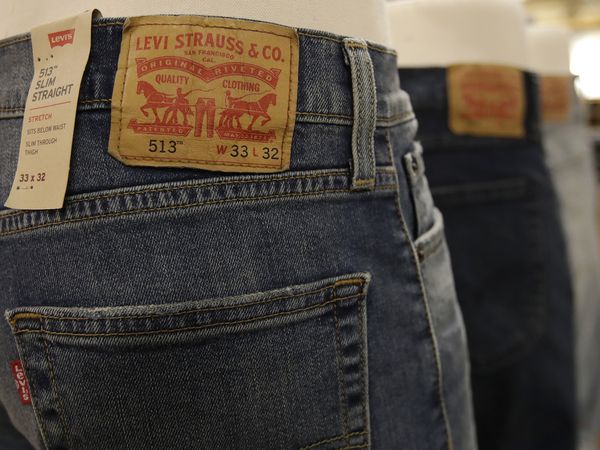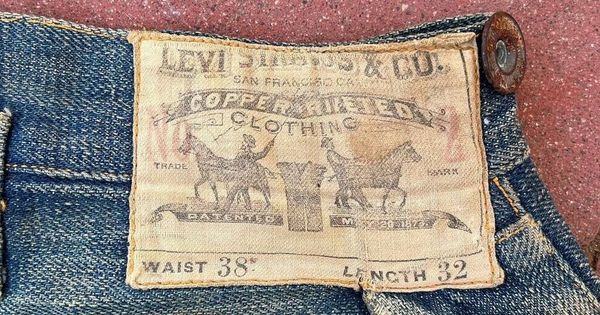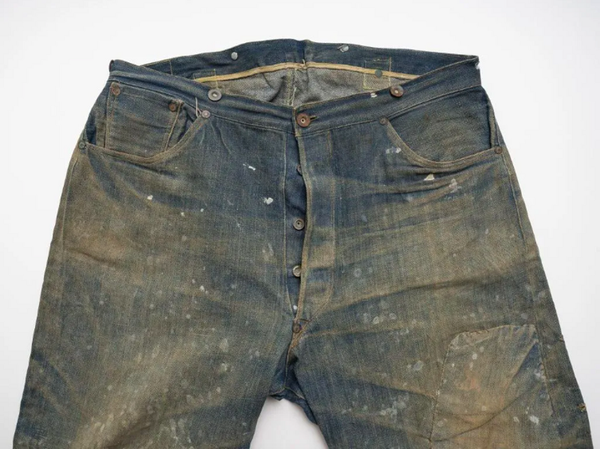
A wax-covered, patched-up pair of Levi’s is giving new meaning to the word “vintage” – and serving as another artifact of America’s dark past.
The jeans, discovered in a mineshaft a few years ago by Michael Allen Harris, a historian of denim, date to the 1880s. They sold this month at a New Mexico auction for $76,000, the Wall Street Journal reported – among the highest prices jeans have ever fetched. The buyers, who each sell vintage clothing, were able to identify the jeans’ age thanks to a number of clues: a missing logo stamp, suspender buttons and a single pocket on the seat, among other indicators.
Another mark of the jeans’ age: a label inside says they are “the only kind made by white labor”.
That message appeared after Congress passed the Chinese Exclusion Act in 1882, amid widespread anti-Chinese racism, particularly as the economy struggled in the 1870s. Such bigotry was particularly prevalent in the west. San Francisco – home to Levi’s, founded in 1853 – drew a large number of Chinese immigrants in the 19th century, and, as Michael Luo wrote in the New Yorker last year, “white workers … began to see the Chinese as competition – first for gold and, later, for scarce jobs.”
The exclusion law, which established a 10-year ban on Chinese laborers seeking to immigrate to the US, became the first major restriction on immigration in the US. It was not repealed until 1943.
In the 1880s, “there was significant social pressure not to hire Chinese workers and [Levi Strauss and Co] adopted an anti-Chinese labor policy,” the company said in an emailed statement. “Levi’s also used advertisements and printing on our products to declare that our products were ‘made by white labor’, thinking it would improve sales and align with the views of consumers at the time.”
In the 1890s, the company said, “we reversed our policy and company leaders began speaking out against the nation’s racist policy.”
Beyond the design elements, the jeans’ age is also clear from the wax spattered across them. Levi’s were worn by silver miners in the west, as Harris wrote in the Guardian in 2015, and miners lit their way with candles, the Journal notes.
All this explains why Harris found them in a western mineshaft. “When a miner got a new pair of work pants, he’d cut up the old ones and use them for lagging around pipes, so there were a lot of antique jeans buried out here,” he wrote in the 2015 piece.

After discovering scraps while looking for antique whiskey bottles, Harris developed “a sort of obsession” with antique jeans and is now what he calls a “denim miner”. The material can sell for hefty sums, but “I’m not focused on the money,” Harris wrote. “I’ve become a sort of archivist and historian.”
Despite their historical significance, you might not know that the jeans were nearly 150 years old if you encountered them in a thrift shop. They’re still fully wearable, according to Zip Stevenson, who paid 10% of the cost; the other 90% was covered by Kyle Haupert, a 23-year-old from San Diego, the Journal reported. The wearability “is a big part of why we believe they are so extremely valuable,” even if “they could use a little mending in a couple of spots”, Stevenson wrote to the Guardian in an email.
Stevenson, who runs Denim Doctors, a Los Angeles business that repairs well-loved clothing, became interested in the material when he worked at a shop selling vintage Levi’s and realized they were selling for more than the brand-new pairs at a store a few doors down. He thinks the 1880s pair is worth “no less than $150,000 and potentially quite a bit more”, he says. “We believe that there’s no reason they would not be worth even up to $1m in the context of other collectible things like rare watches, art by famous artists, rare comic books and sports memorabilia.”
And who might have the money to make such an investment? “I could see a wealthy eccentric person buying them and then wearing them from time to time like people that wear million-dollar Paul Newman Rolex watches,” Stevenson said.
But the ideal buyer would be “someone that will then offer them on permanent loan to a highly visited museum like a Smithsonian or the Metropolitan Museum in New York so that people could see them in perpetuity” as a part of American history, Stevenson added. “We are OK to be patient to find the right home for them.”










